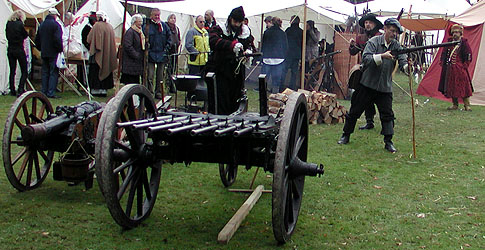

|
Slag om Grolle 22, 23, 24 October, 2010 Groenlo, The Netherlands
This time, instead of 600 re-enactors, 850 were invited, and from more countries: Spain, France, Italy, Netherlands, Luxembourg, Germany, Czech Republic, Poland, Hungary (and one from the United States). As in 2008, the emphasis was living history in addition to three days of battle. Living history campsites were throughout the town’s public parks, with pretty settings among trees and slow waterways, which were sited along the now well-eroded defenses of 1627. Participants/campers were approximately divided by language groups, with English speakers in a different spot from last time, in the flat in front of the outdoor stage and close to the Dutch.
Weeks beforehand, I’d been in contact with the Sealed Knot Royalist
Regiment, Rawdon’s, about being with them for this event as I was for
2008. I was enthusiastically welcomed; they even generously provided for
me a soldier’s tent and filling meals. (I made a small repayment by
presenting the Colonel with a tube of moustache wax and to the Regiment
a gen-oo-ine State of California flag, to be flown and thereby bemuse
others at the plastic camps at next year’s Sealed Knot events.) In
addition to Rawdon’s, other regiments were there from Hopton’s Tercio,
Godolphin’s and Slanning’s, plus I saw the white coats of Newcastle’s.
But instead of being referred to as “Hopton’s,” we had the collective
name of “Cecil’s.” And there were plenty of red coats of Manchester’s, a
stalwart Parliamentarian regiment (which, FYI, fought hard against
Newcastle’s in the Battle of Marston Moor in 1644). Unhappy with so many participants taking photographs of the battle back in 2008, this time organizers specifically forbade bringing out cameras on the field. I was okay by this; my opinion is that one can either fight or take pictures, but not both, and I wanted to fight. 
The battle simulated a siege. At one end, a low bastion was of built-up earth with storm poles set into the sides and on this artillery was mounted. Trenches zigzagged across more than half of the battlefield, with the removed earth heaped on the trench side facing the enemy (so as a trench went from zig to zag, the removed dirt was placed on one side, then the other) with trenching was done with an excavator beforehand. At one end, the Dutch attackers’ end, a low bastion was of built-up earth with storm poles set into the sides and on this artillery was mounted. The Army of Flanders was behind earthworks at the other end. As during the battle in 2008, I could focus only on the situation and people immediately around me, follow orders, and wait-charge-stand-withdraw-wait. What struck me this time was how well orchestrated the overall battle was. Every unit was given the opportunity to fight, sometimes against one enemy unit, then another, sometimes falling back, other times going forward, even attacking. Here and there were event organizers in kit providing cues to participants while discretely using little field radios, much like what cops have.
The first day, Cecil’s was initially held in reserve beside the artillery. The battle grew and we began to wonder if we were to go in – then an officer of a French unit told our Colonel to go with his company forward into battle. We fought the second day with that French unit at our side. In a trench, the enemy pike came at us to make this like a Sealed Knot push of pike. It was a joy for me to mash right in. A French officer was at my immediate left and shouting as loud as he could commands in French. Exhilarating to be back into a pike push AND have a French officer bellow orders in French by my ear.
This time there were eight horse, all very well trained, with their riders equipped as cuirassiers, from the Czech Republic.
On the first day and the third, riders guided their mounts into the
trenches much to the consternation of infantry already in there. Of
course, that infantry reacted, confronting horse with pikes and clubbed
muskets. The riders had their horses leap right out of the trenches and
rush to harass other infantry. Much more - like, many pictures - may be found at the event's official Web site. |